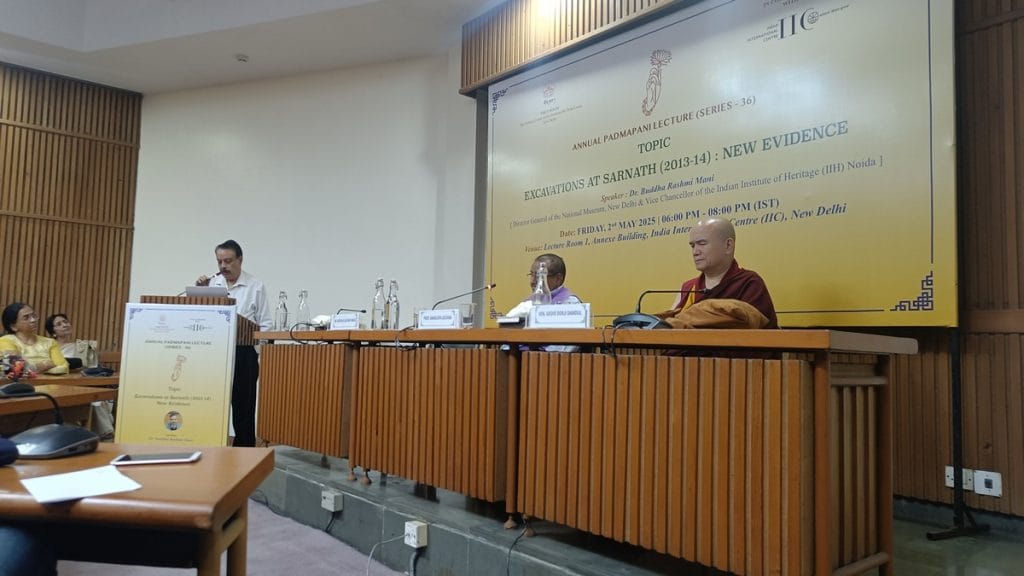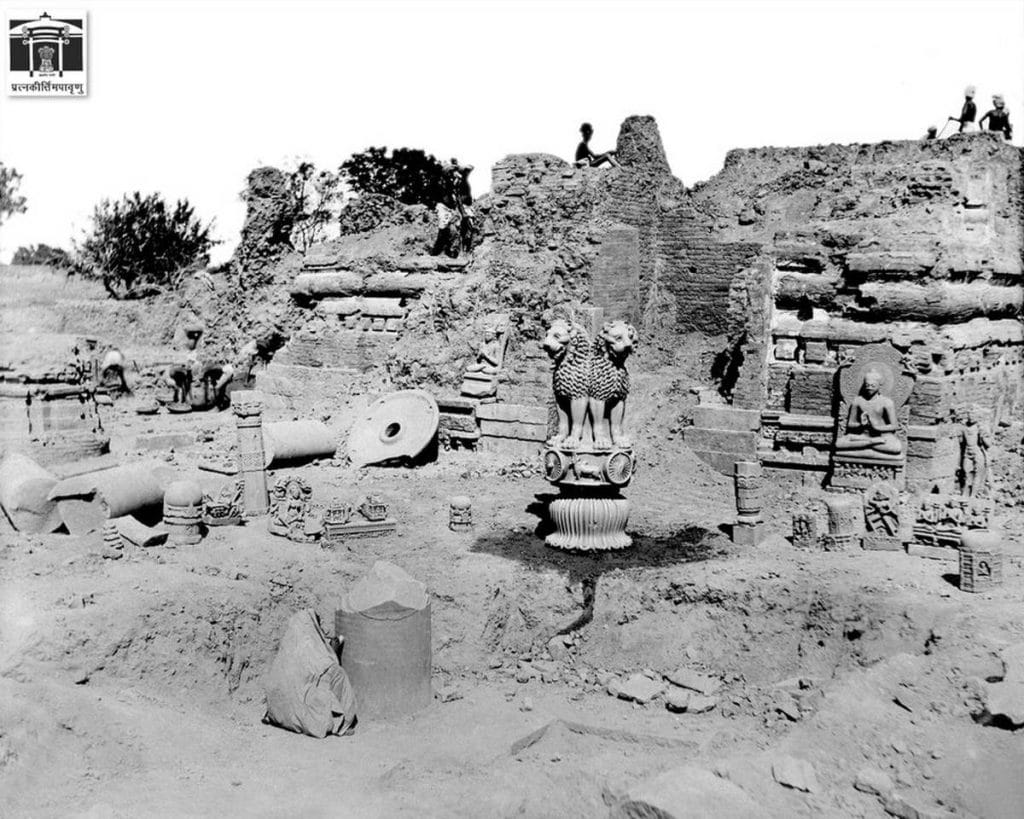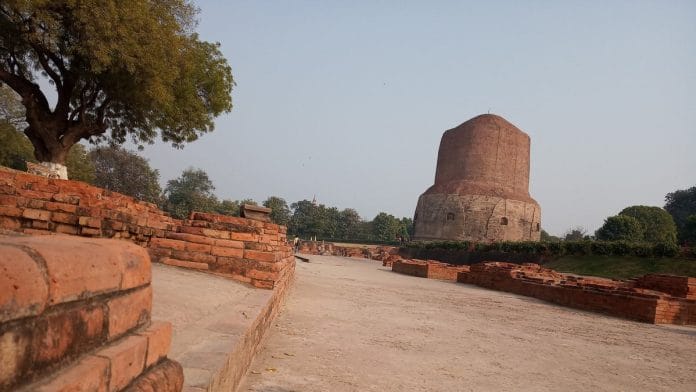New Delhi: Three centuries elapsed between Buddha attaining enlightenment and Ashoka’s rise as Emperor of Magadha in 268 BCE. This niggled at archaeologist and numismatist BR Mani when he launched an excavation at Sarnath in 2013-14.
“There is a common perception that everything started with Ashoka at Sarnath, but I knew that it couldn’t be true,” said Mani, the former director general of the National Museum.
Sarnath, near Varanasi in Uttar Pradesh, was the beating heart of Buddhism in the Magadha empire. All signs, Mani said, pointed to it being a hub of human and religious activity well before Ashoka’s time. He was speaking at the 36th Padmapani Lecture, ‘Excavations at Sarnath (2013-14): New Evidence’, at Delhi’s India International Centre on 2 May.
It’s one of the eight most important Buddhist pilgrimage sites—where Buddha is said to have given his first sermon, and where the Ashoka Pillar stands. Mani’s objective at Sarnath was to fill the gap in the timeline: what happened at Sarnath in the 300 years between Buddha and Ashoka?

“It was problem-oriented work. It was not just digging or excavations, but scientific excavation to find out the truth,” he added.
During the hour-long lecture, organised by Tibet House, Mani highlighted the latest archaeological findings from one of India’s most important historical sites, now a UNESCO World Heritage Site. He compared old images and excavation maps of Sarnath with its present form to show how the site’s landscape had changed over the past century.
“Indian archaeology has undergone many changes, and Sarnath is probably the only example which witnessed the (changing) style of excavations… right from 1815 onward, decades before Alexander Cunningham came into the picture as the first director general of the Archaeological Survey of India,” said Mani.
Also Read: Iron before Indus, Brahmi before Ashoka—archaeologist K Rajan shows Tamil Nadu headstart
Digging for answers
Sarnath is one of the few archaeological sites in India with an excavation history spanning more than 200 years. In 1815, the first surveyor general of India, Colonel Colin McKenzie, initiated work at the site. Later, around 1834-36, Cunningham discovered important structures as well as relics. It was a pivotal moment in Indian archaeology, but the first site museum was established only in 1910 by then ASI director-general Sir John Marshall.
Along with his colleagues Harold Hargreaves and Daya Ram Sahani, Marshall continued excavations in the first half of the 20th century.
“They found the Lion Capital, the famous preaching Buddha statues, the Ashoka Pillar—one of the earliest and most imposing structures at Sarnath, which is our national emblem today,” said Mani.

Everything came to a halt with World War II. There were no excavations at Sarnath until Mani restarted it in 2013-14. Before digging, he and his team had to study all previous excavation reports.
“We located those areas on graph paper and then decided where we could have our trenches,” said Mani, answering an audience member’s question about the most challenging part of the dig.
Mani’s team dug four trenches to find the original bricks and foundations of the structures. They had to go all the way down to the natural soil so they could see the different construction layers and figure out when settlement first began.
They excavated the northern side of the site, where they found a “dump of significant but damaged Buddha sculptures” dating back to the late 4th or early 5th century. The results suggested that the foundation of the Apsara temple rested on a strong base of brick beds.
“There are layers suggesting the construction period,” he said. “We got the carbon samples collected from the site, which were sent to Florida (for testing), and, to everyone’s surprise, we got the dates of early 4th century BCE,” said Mani.
Also Read: Massive reservoir found at Rakhigarhi is giving us more clues on Saraswati River
A buried past
All the evidence suggests that for more than a hundred years before Ashoka, activities related to Buddhism were continuing at Sarnath.
By the 3rd century BCE, Sarnath had become an important centre for the Sammatiya school of Buddhism, which continues to this day. On 2 May, the National Museum presented the Holy Relics of Lord Buddha from Sarnath to Vietnam for an exposition where nearly 40 lakh people came to pay their respects.
During the excavation, the team found a large number of broken sculptures made with red Chunar sandstone. One of the images Mani displayed was of a Buddha with five disciples, featuring the same red tone seen in the later Kushan period (3rd century CE).
As Mani’s team dug deeper, the layers began to tell a story. The excavation uncovered a timeline stretching from the pre-Mauryan period (5th-4th century BCE) through the Mauryan (3rd-2nd century BCE), Shunga (2nd-1st century BCE), Kushan (1st-3rd century CE), Gupta (4th-6th century CE), post-Gupta (7th-9th century CE), and up to the early medieval or Rajput period (10th-12th century CE). It was a continuous thread of history, showing how successive dynasties left their mark on Sarnath in brick and stone.
The major push to turn Sarnath into a Buddhist centre from Emperor Ashoka, who ruled Magadha from Pataliputra nearby. From here on, Sarnath flourished for the next 1,300 years. The Chinese traveller Xuanzang, who visited it around 640 CE, reported hundreds of small shrines, stupas, and viharas. During the Pala period (8th-12th century), too, Sarnath continued to enjoy royal patronage.
That long history came to a brutal end.
“We know very well that around 1194-95 the site was attacked and large-scale destruction took place,” said Mani, referring to Mahmud Ghori’s general Bakhtiyar Khilji’s attack on Buddhist sites from Sarnath to Nalanda.
Mani said his army went toward Nalanda and demolished all the monasteries, burned the library.
Only the remnants of its structures were left to tell the story of Sarnath, which is why archaeological study is so important, according to Mani.
It’s something archaeologists have been attuned to for centuries. Mani said that from 1815 to 2014, Sarnath has a 200-year history of archaeological explorations, starting with Cunningham, “with his own penny”.
“Alexander Cunnighman took up explorations at three stupas and a monastery at Sarnath in 1834 and closed it in January 1836 at a cost of 517 rupees,” he said.
(Edited by Asavari Singh)






